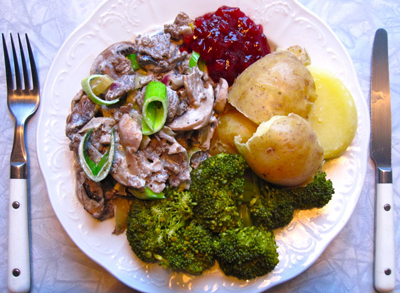Anna Barnwell and Øistein Berget are two Alaskans slash Norwegians that cannot get enough of either location. Anna – a born and raised Anchorageite – first lived in small town Norway as an exchange student, but has since returned multiple times both to visit her partner Øistein and most recently for grad school.

Øistein has also visited Alaska through the years and enjoys being in the Alaskan outdoors and grabbing a great bite to eat either at home or in Anchorage afterwards. They are currently living in Norway, but hope to someday return to Alaska.
Although generally speaking, they miss Alaskan food more than they love Norwegian food culture, there are some highlights of Norwegian cuisine which they love. Norwegians have a rich tradition of using local food from their own ecosystem. So called “traditional” foods in Norway consist largely of foods that they were able to grow here prior to the globalized food market (Wild meat, sheep and cow meat from the farm, fish, potatoes, and basic vegetables). In addition, berries (berry sauces and desserts made of salmonberries, lingonberries, strawberries, blueberries, raspberries) are dear to the heart. Norwegians are good a maintaining local traditions through local foods, something we can all learn from.
Norway and Alaska share a similar climate and love for fishing and hunting. This dish is a wild meat dish. In Norway, elk (or moose, but the Norwegian moose are smaller than Alaskan moose), deer, and reindeer are hunted. This is a primarily reindeer dish. Reindeer can be hunted wild or herded by the local indigenous population called the Sami. The dish they are sharing can be called “Finnish Beef” or “Wild Stew” in local terms.

The dish works well for Alaskans who manage to find any type of wild meat around, even though it works best with reindeer. You can also use normal beef, but Anna prefers wild and local meats if she is going to eat meat at all. In Norway, this dish is associated with winter and autumn, and is perceived as a traditional dish that one could eat on a special occasion or a winter holiday. It is quite heavy!
Wild Meat Stew with Potatoes and Broccoli
Recipe serves 6
Ingredients
- 27 ounces (or 1.6 lb) of Moose, Caribou, Reindeer, or Beef. The meat should be sliced THINLY (appx 0.5 cm thick)
- 0.8 lb of Mushrooms, or half the amount of the meat
- 1 Onion
- 1 spring onion
- 1 cup of water
- 2 cups of cream
- 8 crushed Juniper berries (or more, if you like it!)
- Salt and pepper to taste
- *to reduce the “wild flavor” of the meat you can add beef soup stock.
Process
- Heat a pan with butter. Saute the meat, onion, and mushrooms on strong heat. Saute until the meat is browned.
- Move the mix to a large pot. Make sure to save the juice from the meat and veggies.
- Add water to the pot and let it simmer for 10 minutes or more (up to 35).
- The spring onions should be cut in thick ovular pieces, using the entire spring onion.
- Add the cream, the crushed juniper, and spring onions to the mixture and let it simmer for 5 minutes.
- Taste and add salt and pepper.
On the Side:
- Boiled Potatoes, Mashed Potatoes or Rice. (But in traditional Norwegian culture it is boiled potatoes).
- Steamed Broccoli
- Lingonberry Jam
Lingonberry Jam:
This is a typical side sauce to Scandinavian meat dishes. In the US one can find a version of this at IKEA (!!!), but you can also substitute with homemade bitter/sour jams of choice. The jam should not be sweet with sugar and not too sour either. Cranberry sauce or jam is also a suitable substitute.
The Anchorage Food Mosaic’s mission is to build and celebrate community through our cultural foods.
In our current conventional agricultural system, a monoculture replaces lots of genetically diverse plants with one uniform crop, which is highly susceptible to disease and failure. In the same way that monocropping is dangerous to the future of a crop; we must encourage diversity within our community to prevent disease.
In order for our community to thrive we need to embrace and nurture the “mosaic” of people in this city.
The Anchorage Food Mosaic features different community members through photos and traditional recipes. Let us cook each others cultural foods and share our stories with one another.




